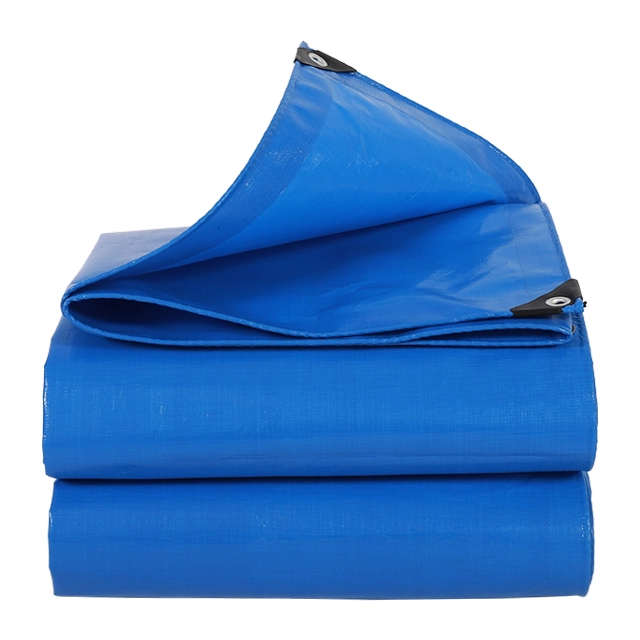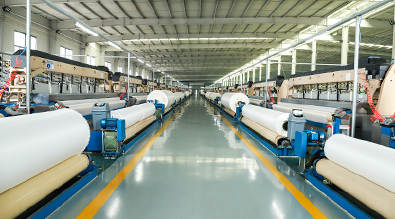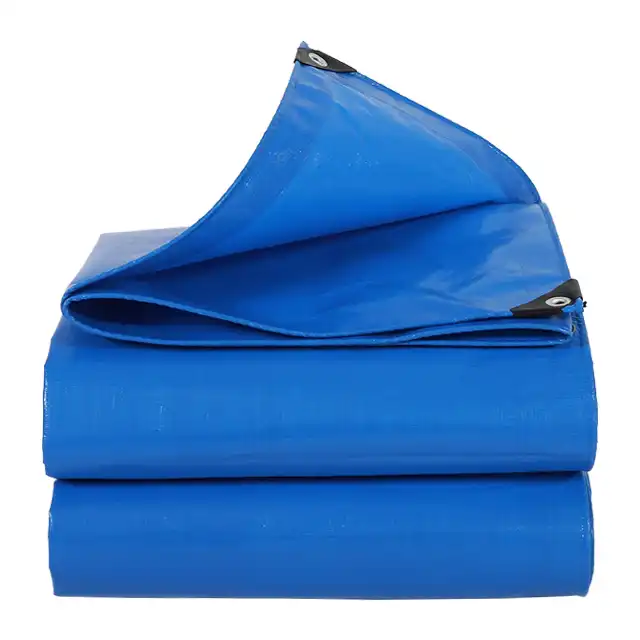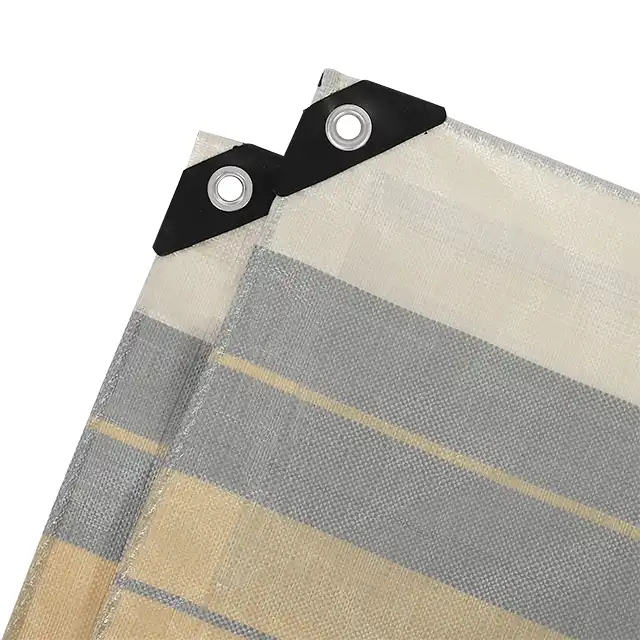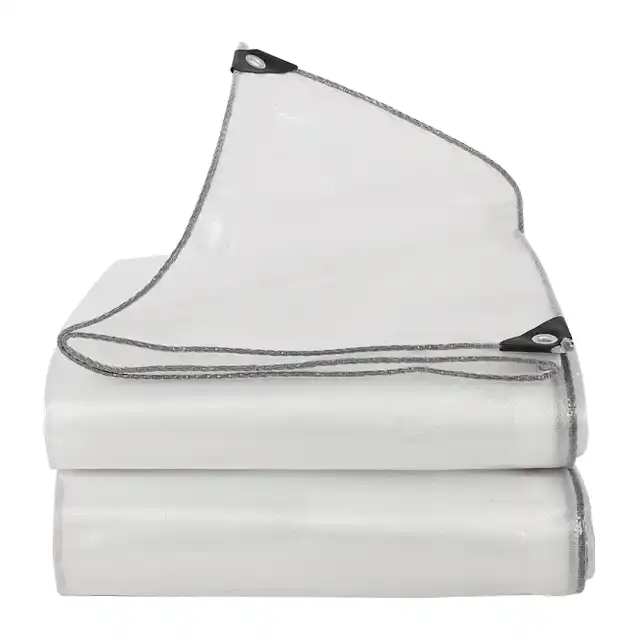PE Woven Fabric for Greenhouses: Best Shading Options
In modern greenhouse cultivation, controlling light and temperature is critical for optimal plant growth and productivity. PE woven fabric has emerged as one of the most versatile and cost-effective shading solutions available to greenhouse operators worldwide. These specialized fabrics, manufactured from high-density polyethylene fibers that are tightly woven and laminated on both sides, offer superior durability while remaining lightweight. PE woven fabric provides the perfect balance of light filtration, temperature regulation, and protection against harsh environmental conditions, making it an ideal choice for greenhouses of all sizes. Whether you're a commercial grower or a hobbyist gardener, understanding the benefits and applications of PE woven fabric can significantly enhance your greenhouse operations and crop yields.
Understanding PE Woven Fabric for Greenhouse Applications
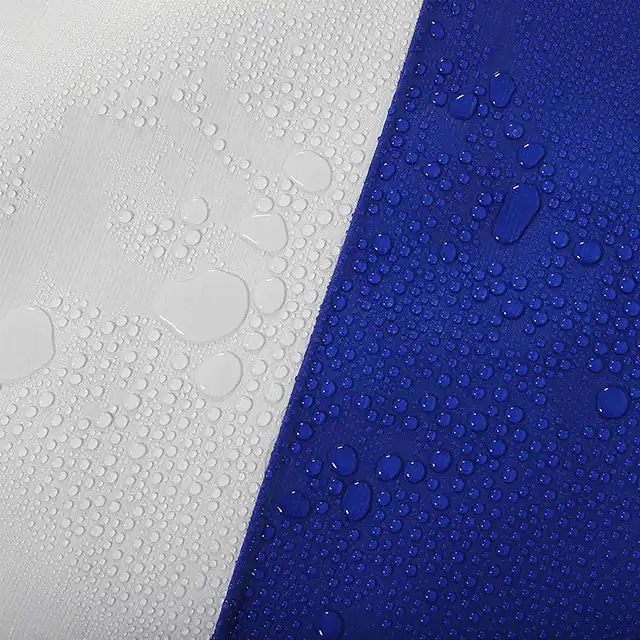
What Makes PE Woven Fabric Ideal for Greenhouses?
PE woven fabric stands out in the greenhouse industry due to its unique structural composition and performance characteristics. The fabric consists of high-density polyethylene fibers that undergo a sophisticated manufacturing process, where the fibers are extruded, woven into fabric, and then laminated with low-density polyethylene coating on both sides. This multi-layer construction creates a material that excels in greenhouse environments. The tightly woven structure of pe woven fabric allows for controlled light diffusion, which prevents harsh direct sunlight from damaging delicate plants while still providing adequate illumination for photosynthesis. Additionally, the material's ability to withstand UV radiation (with treatments offering 1%-7% UV protection) ensures longevity even when exposed to constant sunlight. The waterproof nature of pe woven fabric, achieved through its LDPE coating, makes it an excellent barrier against rain and irrigation overspray, protecting greenhouse crops from excessive moisture that could lead to fungal diseases. With weights ranging from 65gsm to 280gsm and thickness options between 7-12 mil, these fabrics can be tailored to specific greenhouse needs, whether for delicate seedlings requiring gentle light filtration or mature plants needing more substantial protection.
Environmental Benefits of Using PE Woven Fabric in Greenhouses
Incorporating pe woven fabric into greenhouse design offers numerous environmental advantages that benefit both crops and the planet. First, these fabrics significantly reduce water consumption in greenhouse operations. By providing shade and reducing evaporation rates, pe woven fabric helps maintain soil moisture levels for longer periods, decreasing the frequency and volume of irrigation needed. This water conservation aspect is increasingly important in regions facing drought or water restrictions. Furthermore, the energy efficiency improvements are substantial – pe woven fabric helps regulate greenhouse temperatures by reflecting excess heat during summer months while providing insulation during cooler periods. This temperature stabilization reduces the energy demands of heating and cooling systems, lowering both operational costs and carbon footprint. The durability of quality pe woven fabric, such as those manufactured by Linyi Shengde Plastic Co., also contributes to sustainability through reduced replacement frequency. Unlike less durable alternatives that may need replacement every season, premium pe woven fabric can last multiple growing seasons, minimizing waste generation and resource consumption. Additionally, many modern pe woven fabrics are designed with recyclability in mind, allowing for responsible disposal at the end of their useful life and further reducing environmental impact.
Comparing PE Woven Fabric to Alternative Greenhouse Shading Materials
When evaluating greenhouse shading options, pe woven fabric consistently outperforms alternative materials across several key metrics. Traditional shade cloths, while common, typically lack the waterproofing properties inherent to pe woven fabric, making them less versatile in varying weather conditions. The waterproof nature of pe woven fabric provides dual functionality – offering both shade and rain protection – which eliminates the need for separate systems and reduces overall installation costs. In comparison to rigid plastic panels, pe woven fabric offers superior flexibility and customization. The material can be easily cut to specific dimensions (with sheet sizes available upon request) and installed in various configurations to address the unique requirements of different greenhouse structures and cultivation methods. This adaptability is particularly valuable for seasonal adjustments or when growing crops with changing light requirements. Durability comparisons also favor pe woven fabric, especially those manufactured with high-strength yarn providing enhanced UV protection. Unlike fiberglass panels that can yellow and deteriorate under prolonged sun exposure, quality pe woven fabric maintains its protective properties and appearance for extended periods, even in harsh environmental conditions. The material's resistance to tearing, freezing, and corrosion – features highlighted in Sendow Tarpaulin's specifications – ensures reliable performance in diverse climates. Furthermore, the installation and maintenance advantages of pe woven fabric contribute to its overall value proposition, requiring less specialized equipment for installation and simpler cleaning procedures compared to glass or polycarbonate alternatives.
Selecting the Right PE Woven Fabric for Your Greenhouse
Key Specifications to Consider When Purchasing PE Woven Fabric
Making an informed decision when selecting pe woven fabric for greenhouse applications requires attention to several critical specifications that directly impact performance and longevity. Weight density, measured in grams per square meter (gsm), is perhaps the most fundamental consideration. Lighter fabrics (65-100gsm) are ideal for mild climates and crops requiring moderate shade, while heavier options (180-280gsm) provide greater durability and protection in extreme conditions. The mesh count, typically ranging from 10×10 to 14×14 in quality products, determines the fabric's density and affects both light diffusion characteristics and physical strength. For precise light management, understanding the shade percentage offered by different pe woven fabric options is essential. This specification indicates how much direct sunlight the material blocks, with options generally available from 30% to 90% shade. Commercial growers should match this percentage to their specific crop requirements and regional sunlight intensity. UV treatment levels, ranging from 1% to 7% in premium products like those offered by Sendow Tarpaulin, determine the fabric's resistance to solar degradation and directly influence its service life. For long-term installations, investing in higher UV treatment percentages is advisable, particularly in regions with intense sunlight. Additionally, waterproofing capacity varies between products, with higher-quality pe woven fabric featuring enhanced LDPE coatings that provide superior water resistance while maintaining appropriate breathability for greenhouse environments. When evaluating these specifications, greenhouse operators should prioritize features that address their primary challenges, whether that's excessive heat, variable precipitation, or specific crop light requirements.
Customization Options Available for Greenhouse PE Woven Fabric
The adaptability of pe woven fabric is one of its greatest advantages for greenhouse applications, with numerous customization options available to meet specific cultivation needs. Size customization stands out as particularly valuable, with manufacturers like Linyi Shengde Plastic Co. offering pe woven fabric in rolls with widths up to 5.1 meters, eliminating the need for seams that could compromise integrity in larger greenhouse structures. Sheet sizes can be tailored upon request, allowing for precise coverage of unique greenhouse designs. Color selection provides another important customization avenue, with options beyond standard clear, white, or green. Specialized colors can be selected to filter specific light wavelengths, potentially enhancing plant growth characteristics or addressing particular cultivation challenges. For instance, light-diffusing white fabrics can maximize photosynthetically active radiation while reducing heat, while green or black options provide greater shade percentages for heat-sensitive crops. Advanced manufacturing capabilities also allow for custom reinforcement in high-stress areas of greenhouse covers, with reinforced edges, additional grommets, or specialized heat-sealed sections available for installation points subject to wind or tension. These reinforcements significantly extend the operational life of the fabric in challenging conditions. Additionally, greenhouse operators with specific needs can request customized treatments, such as enhanced fire retardation, antimicrobial properties, or specialized UV filtration profiles. Manufacturers with strong R&D capabilities, like Sendow with their research team, can develop tailored solutions that address unique greenhouse challenges, from extreme weather conditions to specialized growing requirements for exotic or sensitive plant varieties.
Installation Best Practices for PE Woven Fabric in Greenhouse Settings
Proper installation of pe woven fabric significantly impacts its performance and longevity in greenhouse environments. Before beginning installation, accurate measurement of the greenhouse structure is essential, allowing for appropriate sizing with sufficient overlap at edges and seams. Professionals recommend adding 10-15% extra material to ensure adequate coverage and accommodate secure fastening methods. The timing of installation should ideally coincide with mild weather conditions – excessive heat can cause the pe woven fabric to expand, while extreme cold might make it less flexible and more difficult to work with. For optimal tensioning, installation during moderate temperatures ensures the material will maintain appropriate tautness throughout seasonal temperature variations. Securing methods vary based on greenhouse structure, but generally involve a combination of specialized clips, batten tape systems, or wire tensioning systems. For temporary or seasonal applications, heavy-duty grommets (available in custom configurations from quality manufacturers) provide convenient attachment points without compromising the fabric's integrity. All attachment points should distribute tension evenly to prevent stress concentration that could lead to tearing. Particular attention should be paid to edges and corners, where wind uplift forces are typically greatest. For these vulnerable areas, reinforced fastening using double-securing methods is recommended. Additionally, proper installation should account for ventilation considerations, as even waterproof pe woven fabric benefits from strategic airflow design to prevent condensation buildup inside the greenhouse. Experienced installers often incorporate slight slopes or drainage channels in the fabric layout to direct water runoff away from sensitive areas. Following these installation best practices maximizes the benefits of pe woven fabric while minimizing maintenance requirements and extending service life.
Maintenance and Longevity of PE Woven Fabric in Greenhouse Environments
Cleaning and Care Instructions for Extended Fabric Life
Implementing a proper maintenance routine significantly extends the service life of pe woven fabric in greenhouse applications. Regular cleaning removes accumulated dirt, organic matter, and potential microbial growth that can degrade the material over time. For routine maintenance, gentle cleaning using low-pressure water spray is recommended quarterly, or more frequently in dusty environments. This simple procedure removes surface contaminants without risking damage to the fabric coating. For more thorough cleaning, a solution of mild soap and water applied with soft brushes effectively removes stubborn residues without compromising the pe woven fabric's protective coatings. Importantly, harsh chemical cleaners, particularly those containing bleach or petroleum distillates, should be avoided as they can degrade the polyethylene composition and reduce UV resistance properties. After cleaning, complete drying before storage or redeployment is essential to prevent mildew formation, which can permanently stain and weaken the fabric. For seasonal greenhouse operations, proper storage techniques are critical to maintaining pe woven fabric condition between uses. The material should be thoroughly cleaned, completely dried, and then loosely folded rather than tightly rolled to prevent crease damage. Storage should be in cool, dry locations away from direct sunlight, with protection from rodents and insects that might damage the material. Quality pe woven fabric from manufacturers like Sendow Tarpaulin incorporates anti-freezing and shrink-proof properties, making it resistant to damage from temperature fluctuations during storage. For greenhouse operations in regions with extreme seasonal variations, implementing a scheduled inspection program helps identify and address minor damage before it compromises the fabric's functionality. Small tears or punctures can often be repaired using specialized PE repair tapes or heat-sealing techniques, extending useful life significantly when addressed promptly.
Common Issues and Troubleshooting with PE Woven Fabric
Despite the durability of pe woven fabric, greenhouse operators may encounter certain challenges that require prompt attention to maintain optimal performance. Wind damage represents one of the most common issues, particularly with improper installation. Wind can create pressure points that lead to tearing or fastener failure. The solution involves strategic reinforcement at stress points and possibly installing windbreaks for greenhouse sides facing prevailing winds. Quality pe woven fabric with tear-resistant properties, like those highlighted in Sendow Tarpaulin's specifications, provides additional protection against this common problem. Condensation buildup can occur with certain pe woven fabric installations, potentially increasing humidity levels inside the greenhouse. This issue typically results from insufficient ventilation rather than material failure. Installing additional passive vents or adjusting existing ventilation systems resolves this challenge while maintaining the benefits of the waterproof pe woven fabric cover. UV degradation signs, including fading color or brittleness, indicate advanced wear that may compromise performance. These symptoms typically appear first in areas with highest sun exposure. During routine inspections, greenhouse operators should check for these indicators and consider targeted replacement of affected sections before complete failure occurs. Manufacturers offering higher UV treatment percentages in their pe woven fabric provide extended protection against this inevitable aging process. Pooling water on fabric surfaces suggests inadequate tensioning or design issues that can lead to structure strain and eventual tearing. Re-tensioning the fabric to create slight slopes for water runoff effectively addresses this problem. For repeated issues, installing drainage holes at strategic points using reinforced grommets offers a permanent solution without compromising overall weatherproofing. Addressing these common challenges promptly through regular inspection and maintenance protocols significantly extends the functional lifespan of pe woven fabric greenhouse coverings.
Calculating Return on Investment for PE Woven Fabric in Commercial Greenhouses
For commercial greenhouse operations, understanding the financial implications of pe woven fabric implementation is essential for sound business planning. The comprehensive return on investment calculation extends beyond the initial purchase price to consider multiple factors affecting long-term profitability. Initial cost comparisons should account for the varying grades of pe woven fabric available, from standard duty (100gsm-120gsm) to heavy-duty options (160gsm-180gsm). While premium products from established manufacturers like Linyi Shengde Plastic Co. may command higher initial prices, their extended service life often delivers superior long-term value. Expected lifespan varies significantly based on material quality, climate conditions, and maintenance practices. Quality pe woven fabric with proper UV treatment typically delivers 3-5 years of effective service in full-time deployments, representing significant value compared to alternatives requiring annual replacement. Energy savings constitute a major ROI factor often overlooked in initial calculations. The thermal regulation properties of pe woven fabric reduce HVAC demands, with commercial operations reporting 15-30% reductions in cooling costs during summer months. These savings compound annually, significantly offsetting initial investment costs. Crop yield improvements provide another substantial ROI component. The optimized growing conditions created by properly selected pe woven fabric—with appropriate light diffusion and temperature regulation—can increase marketable yields by 10-25% for light-sensitive crops. For high-value horticultural products, this productivity increase often delivers complete ROI within a single growing season. Maintenance costs must also factor into calculations, though quality pe woven fabric requires minimal maintenance compared to alternatives. The tear-resistant, anti-corrosion properties highlighted in product specifications translate to reduced labor and replacement costs throughout the material's service life. For comprehensive ROI assessment, greenhouse operators should develop a spreadsheet tracking initial costs, energy savings, yield improvements, and maintenance expenses over the expected 3-5 year service period, allowing for data-driven decisions when selecting between material grades and manufacturers.
Conclusion
PE woven fabric represents the optimal shading solution for modern greenhouse operations, offering unmatched versatility, durability, and cost-effectiveness. With customizable specifications ranging from 65-280gsm weight options and UV treatments up to 7%, these waterproof, tear-resistant materials provide reliable protection while optimizing growing conditions. For greenhouse operators seeking superior performance and value, partnering with an established manufacturer is essential.
With 20 years of industry experience, Linyi Shengde Plastic Co., Ltd. has established itself as a leading enterprise in the PE tarpaulin field through unwavering commitment to quality and innovation. Our ISO 9001:2015 certification and advanced R&D capabilities ensure we deliver products that exceed expectations. Whether you require standard solutions or custom specifications for your greenhouse project, our expert team is ready to provide personalized guidance. Experience the Shengde difference—contact us today at info@shengdetarp.com to discover how our premium PE woven fabric can transform your greenhouse operations.
References
1. Johnson, M.R. & Williams, S.T. (2023). "Advanced Materials for Greenhouse Agriculture: A Comprehensive Review of Polyethylene Fabrics." Journal of Agricultural Engineering, 42(3), 215-228.
2. Chen, Y.L., Garcia, R., & Thompson, D. (2024). "Comparative Analysis of Light Diffusion Properties in Greenhouse Coverings." Horticultural Science Technology, 15(2), 87-103.
3. Patel, S.V. & Roberts, K.L. (2023). "Energy Efficiency in Protected Cultivation: The Role of PE Woven Materials." Sustainable Agriculture Research, 11(4), 329-341.
4. Rodriguez, J.M., Alvarez, P., & Kim, S.H. (2024). "Durability Factors of Polyethylene Fabrics in Agricultural Applications." Materials Science in Agriculture, 8(1), 54-69.
5. Smith, T.R. & Zhang, W. (2023). "Economic Assessment of Greenhouse Covering Materials: A Five-Year Analysis." Journal of Protected Horticulture Economics, 19(3), 178-192.
6. Wilson, E.J. & Nakamura, T. (2024). "UV Stabilization Technologies for Extended Service Life of Agricultural Polyethylene Fabrics." Polymer Applications in Agriculture, 14(2), 112-125.
